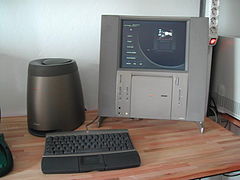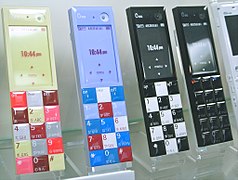| Naoto Fukasawa | |
|---|---|
| 深澤 直人 | |
 | |
| Born | 1956 (age 68–69) Kōfu, Yamanashi Prefecture, Japan |
| Nationality | Japanese |
| Alma mater | Tama Art University |
| Occupation | Industrial designer |
| Website | naotofukasawa |
Naoto Fukasawa (深澤 直人; born 1956) is a Japanese designer, author, and educator, working in the fields of product and furniture design. He is known for his product design work with the Japanese retail company Muji, as well as collaborations with companies such as Herman Miller, Alessi, B&B Italia, Emeco, Magis, and HAY.


Fukasawa has been described as one of the world's most influential designers.
Biography
Fukasawa was born in Kōfu, Yamanashi Prefecture, Japan in 1956. He studied product design at Tama Art University graduating in 1980. After graduating, Fukasawa worked as a product developer at Seiko Epson until 1988, before joining the design firm ID Two, a predecessor to the design consulting firm IDEO in San Francisco, California, for whom he later established a Tokyo office in 1996. During this time he collaborated with the English industrial designer Sam Hecht. In 2002, Fukasawa became a MUJI advisory board member, and worked on the development of many of their products. After leaving IDEO, he established his own independent firm Naoto Fukasawa Design in 2003. In the same year, Fukasawa founded the "±0" (Plus Minus Zero) brand of household electrical appliances and household products, focused on the design of goods that are felt to be "just right". In recent years, he has several Italian furniture companies including B&B Italia, Driade, Magis, Artemide, Danese, and Boffi, as well several in Germany and Northern Europe.
He is one of the co-directors of 21 21 DESIGN SIGHT, Japan's first design museum. Since 2012, he has been the director of the Japan Folk Crafts Museum.
Since 2014, Fukasawa has taught Integrated Design at Tama Art University as a professor, and previously taught at Musashino Art University.
Many of his works are included in the permanent collection at the Museum of Modern Art (MoMA) including, MUJI's Wall-mounted Compact Disc Player (1999), Neon Cellular Phone by KDDI Corporation (2005), and Infobar Cellular Phone by KDDI Corporation (2003).
Design approach

Naoto Fukasawa's design approach is centered around the relationship between design and behavior, using terms such as "design dissolving in behavior", "center of consciousness", "normality", "outline" and "archetype" to describe his work. His approach relies on observing how people act and react in their everyday, and finding solutions in these behaviors that link the design to the person. In his 2018 monograph, Fukasawa describes design as "attributing countenance to an object", in which the design is accompanied by the environment and the context.
Fukasawa coined the term "Without Thought" as a philosophy for how design can be found in people's unconscious behavior. Without Thought refers to how objects can feel important when seen for the first time, but only have their initial essence realized when being used. Ever since creating the term, Fukasawa has organized workshops to share his approach to other designers.
In 2006, Fukasawa curated the exhibition Super Normal together with English furniture designer Jasper Morrison to define "Super Normal", presenting 200 objects that were considered ordinary or to have been anonymously designed. Items presented in the exhibition ranged from notable objects such as the Bialetti espresso maker to anonymously designed and mass produced objects such as disposable plastic plates. The term defines objects as being absent of identity, originality, and elements that leave an impression, leading to objects that appear ordinary. This design concept can be seen reflected in Fukasawa's work with Muji, where products are created with an anti-branding approach of not presenting any traits that characterize the object.
Select awards
Fukasawa has won over fifty awards, including the American IDEA Gold Award, the German iF Gold Award, the British D&AD Gold Award, the Mainichi Design Award and the 5th Oribe Award.
- 1991 – IDEA Gold Award
- 1994 – Red Dot
- 1996 – iF Gold Award
- 2003 – Mainichi Design Prize
- 2005 – 5th Oribe Award
- 2007 – Royal Designer for Industry (Royal Society of Arts), in Product Design.
- 2014 – Good Design award
- 2018 – Isamu Noguchi Award
Select exhibitions
- 2006, Super Normal, curated by Jasper Morrison and Naoto Fukasawa at Axis Gallery, Tokyo, Japan
- 2016–17, The Boundary between Kogei and Design at the 21st Century Museum of Contemporary art, Kanazawa
Works
Naoto Fukasawa has consulted and designed for several companies, ranging from home appliance retailers to furniture manufacturers. Companies that he has designed for include:
- KDDI Corporation
- INFOBAR Cellular Phone, 2003
- INFOBAR 2 Cellular Phone, 2006
- neon Cellular Phone, 2006
- INFOBAR A03 Smartphone, 2015
- ±0 (Plus Minus Zero)
- A Light with a Dish, 2003
- Wire frame Houseware, 2010
- Toaster, 2007
- Muji
- Wall-mounted CD player, 1999
- Refrigerator, 2014
- Electric Kettle, 2014
- Rice Cooker, 2014
- Samsung
- N310 Netbook, 2009
- Multi Xpress7 Color Printer, 2015
- Maruni
- Hiroshima Furniture Collection, 2010–2016
- B&B Italia
- Belle and Bull, Chair and Table, 2018
- HAY
- Pao lamp series
- realme
- realme GT Master Edition
- realme GT 2
- realme GT 2 Pro
Publications
- Fukasawa, Naoto (2018). Naoto Fukasawa: Embodiment. Phaidon Press. ISBN 9780714876078.
- Fukasawa, Naoto (2014). Naoto Fukasawa. Phaidon Press. ISBN 978-0714866031.
- Fukasawa, Naoto (2005). An Outline of Design. Japan: TOTO Shuppan.
- Fukasawa, Naoto; Goto, Takeshi; Sasak, Masato (2004). The Ecological Approach to Design. Japan: Tokyo Shosek.
Gallery
-
 Wall-mounted CD player for Muji
Wall-mounted CD player for Muji
-
 Twentieth Anniversary Macintosh for Apple
Twentieth Anniversary Macintosh for Apple
-
 neon (Phone)
neon (Phone)
-
 INFOBAR (Phone)
INFOBAR (Phone)
-
 INFOBAR C01 (Phone)
INFOBAR C01 (Phone)
-
 INFOBAR 2 (Phone)
INFOBAR 2 (Phone)
-
IS01 (Smartbook)
References
- "naoto fukasawa interview". designboom. 2004-04-18. Retrieved 2019-01-25.
- "The Pao collection of lamps is an exciting collaboration with designer Naoto Fukasawa – HAY". Scandinaviandesign.com. 21 November 2020. Retrieved 1 May 2022.
- "World's Most Influential Designers". Bloomberg.com. Archived from the original on 3 September 2012. Retrieved 2019-01-25.
- ^ "Naoto Fukasawa, Lighting Designer Profile". www.lightology.com. Retrieved 2019-01-25.
- "Antiques of the Future, Naoto Fukasawa". mydesignlife.com. Retrieved 2019-01-25.
- ^ "Naoto Fukasawa". naotofukasawa.com. Retrieved 2021-04-14.
- "DESIGN IN MIND: Naoto Fukasawa". Arkitektura Assembly. 2015-10-08. Retrieved 2019-01-25.
- ^ "Best Practice, Naoto Fukasawa, Product Design". Red Dot. Archived from the original on 2008-02-08. Retrieved 2019-01-24.
- "COMPANY OVERVIEW | プラスマイナスゼロ" (in Japanese). 2017-02-02. Retrieved 2021-04-14.
- "Art Space Tokyo". 21_21 Design Sight: Tokyo Art Maps. Retrieved 2012-01-09.
- Ashcraft, Brian (2007-05-01). "Without Thought". Metropolis. Archived from the original on 2007-10-05. Retrieved 2019-01-24.
- Prescott, Judith (2009-01-13). "Japanese design comes of age". RFI. Retrieved 2019-01-25.
- ^ "Naoto Fukasawa | MoMA". The Museum of Modern Art. Retrieved 2019-01-25.
- ^ "Industrial Designer Naoto Fukasawa on His Creative Process". Metropolis. 2018-03-19. Retrieved 2019-01-25.
- Bartal, Ory (2020). "Mujirushi Ryohin and the absence of style". Critical design in Japan: Material culture, luxury, and the avant-garde (1 ed.). Manchester University Press. p. 143. ISBN 978-1-5261-3997-9. JSTOR j.ctvzgb83c.
- ^ "Naoto Fukasawa Not Just Winning Awards—Now He's Designing Them". Core77. Retrieved 2019-01-25.
- "Naoto Fukasawa". www.awmagazin.de (in German). 2011-04-05. Retrieved 2019-01-25.
- "What Are the G-Mark and Good Design Award?". Core77. Retrieved 2019-01-25.
- "Jasper Morrison | Super Normal". jaspermorrison.com. Retrieved 2021-04-14.
- "金沢21世紀美術館". 金沢21世紀美術館. Retrieved 2021-04-14.
- "Naoto Fukasawa Design | INFOBAR 2". naotofukasawa.com. Retrieved 2021-04-14.
- "Naoto Fukasawa Design | neon". naotofukasawa.com. Retrieved 2021-04-14.
- "Naoto Fukasawa Design | INFOBAR A03". naotofukasawa.com. Retrieved 2021-04-14.
- "Naoto Fukasawa Design | A Light with a Dish". naotofukasawa.com. Retrieved 2021-04-14.
- "Naoto Fukasawa Design | Egg Carton, Wire Basket, Toast Stand". naotofukasawa.com. Retrieved 2021-04-14.
- "Naoto Fukasawa Design | Toaster". naotofukasawa.com. Retrieved 2021-04-14.
- Cooper Hewitt, Smithsonian Design Museum. "Muji Wall-mounted CD Player, designed 1999; manufactured 2013". Smithsonian Institution. Retrieved 14 April 2021.
- "Naoto Fukasawa Design | Refrigerator". naotofukasawa.com. Retrieved 2021-04-14.
- "Naoto Fukasawa Design | Electric Kettle". naotofukasawa.com. Retrieved 2021-04-14.
- "Naoto Fukasawa Design | Rice Cooker". naotofukasawa.com. Retrieved 2021-04-14.
- "Naoto Fukasawa Design | N310, notebook PC". naotofukasawa.com. Retrieved 2021-04-14.
- "Naoto Fukasawa Design | Multi Xpress7, Multi-function Color Printer". naotofukasawa.com. Retrieved 2021-04-14.
- Maruni Wood Industry. "Hiroshima". Retrieved April 14, 2021.
- "Table Bull -B&B Italia – Design of Naoto Fukasawa". B&B Italia. 2018-04-17. Retrieved 2021-04-14.
- "Chair Belle -B&B Italia – Design of Naoto Fukasawa". B&B Italia. 2018-04-17. Retrieved 2021-04-14.
- "Naoto Fukusawa". HAY. Retrieved 1 May 2022.
- "Here's the first look at Naoto Fukasawa designed Realme GT Master Edition". Pinkvilla.
- "realme GT 2 Pro – Designed by Naoto Fukasawa". Realme.
External links
- Naoto Fukasawa Design
- NAOTO FUKASAWA DESIGN LTD. (naoto_fukasawa_design_ltd) – Instagram
- ±0 (PLUS MINUS ZERO)
- Naoto Fukasawa Furniture Designs
- Naoto Fukasawa – Interview
- Radio France International feature on Japanese design in the 21st century